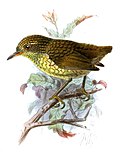Dendroplex
In the following article, we will delve into the exciting world of Dendroplex and explore its many facets. From its intriguing origin to its current repercussions, we will delve into this topic to unravel its secrets. Through exhaustive analysis and a critical approach, we aim to shed light on Dendroplex, offering our readers a comprehensive and informed view of this fascinating field. Join us on this tour of Dendroplex and discover everything behind this enigmatic universe.
| Dendroplex | |
|---|---|

| |
| Straight-billed woodcreeper (Dendroplex picus) | |
| Scientific classification | |
| Domain: | Eukaryota |
| Kingdom: | Animalia |
| Phylum: | Chordata |
| Class: | Aves |
| Order: | Passeriformes |
| Family: | Furnariidae |
| Subfamily: | Dendrocolaptinae |
| Genus: | Dendroplex Swainson, 1827 |
| Type species | |
| Oriolus picus Gmelin, JF, 1788
| |
| Species | |
Dendroplex is a genus of birds in the woodcreeper subfamily Dendrocolaptinae. It was long merged into Xiphorhynchus, but its distinctness has now been established.[1]
Taxonomy
The genus Dendroplex was introduced in 1827 by the English naturalist William Swainson.[2] The genus name combines the Ancient Greek dendron meaning "tree" with plēssō meaning "to strike".[3] Swainson did not specify a type species but this was fixed in 2007 as the straight-billed woodcreeper which had first been described in 1788 by Johann Friedrich Gmelin with the binomial name Oriolus picus.[4][5]
The genus contains two species:[6]
| Image | Scientific name | Common Name | Distribution |
|---|---|---|---|
 |
Dendroplex picus | Straight-billed woodcreeper | Bolivia, Brazil, Colombia, Ecuador, French Guiana, Guyana, Panama, Peru, Suriname, Trinidad and Tobago, and Venezuela. |
 |
Dendroplex kienerii | Zimmer's woodcreeper | Amazon river and tributaries |
References
- ^ Aleixo, Alexandre (2002). "Molecular systematics and the role of the "Várzea"–"Terra-Firme" ecotone in the diversification of Xiphorhynchus woodcreepers (Aves: Dendrocolaptidae)". The Auk. 119 (3): 621–640. doi:10.1093/auk/119.3.621.
- ^ Swainson, William (1827). "On several groups and forms in ornithology, not hitherto defined". Zoological Journal. 3: 158–175, 343–363 .
- ^ Jobling, James A. (2010). The Helm Dictionary of Scientific Bird Names. London: Christopher Helm. p. 133. ISBN 978-1-4081-2501-4.
- ^ Aleixo, A.; Gregory, S.M.S.; Penhallurick, J. (2007). "Fixation of the type species and revalidation of the genus Dendroplex Swainson, 1827 (Dendrocolaptidae)". Bulletin of the British Ornithologists' Club. 127: 242–246.
- ^ Dickinson, E.C.; Christidis, L., eds. (2014). The Howard & Moore Complete Checklist of the Birds of the World. Vol. 2: Passerines (4th ed.). Eastbourne, UK: Aves Press. p. 115. ISBN 978-0-9568611-2-2.
- ^ Gill, Frank; Donsker, David; Rasmussen, Pamela, eds. (January 2023). "Ovenbirds, woodcreepers". IOC World Bird List Version 13.1. International Ornithologists' Union. Retrieved 6 March 2023.
